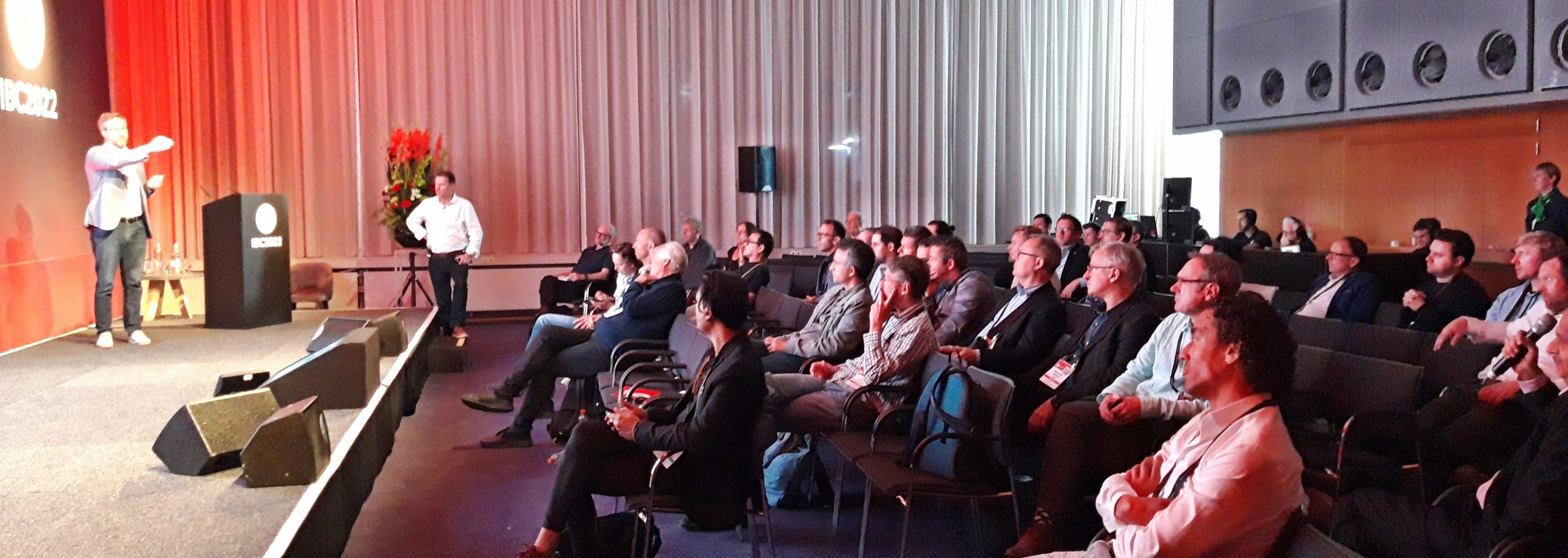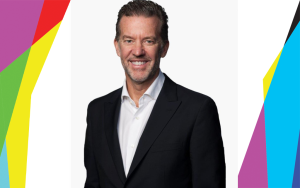EDCF seminar highlighted cinema technology trends at IBC 2022
In this year’s overall conference programme at IBC, cinema technology played only a minor role. That gave EDCF’s Global Cinema Seminar, “Cinema Looks Forward To A Changing Future”, the opportunity to not only fill this gap but make it one of the highlights of the last day of the show with leading industry experts taking center stage.
Over 60 attendees filled up the small conference room, far more than those on the organisers’ registration list. The agenda included a general market overview and current industry topics such as cybersecurity, HDR, the cinema ecosystem and its challenges, audio quality in the cinema, and more.
In his opening keynote David Hancock, Chief Analyst at OMDIA, presented the latest figures on the international cinema market, which has been hit hard by the pandemic-related shutdowns of recent years. Hancock refers to the “Covid-19 gap”, which saw significant revenue losses for both cinema operators and distributors. While there has been a noticeable recovery this year, with attendance back up to 2019 levels at times in many places, it has not been consistent across all markets.
While some markets, including the UK, saw strong growth in attendance figures this year, some took longer to regain their footing. Yet overall, the industry sees an upward trend. However, visitor loyalty strongly depends on content: Local content was found to be a driving force for recovery in individual markets although Hollywood is still king. When it comes to Hollywood films, only blockbuster sequels like “Spider-Man: No Way Home” and “Top Gun: Maverick” dominated the box office.
The future of the international cinema markets as a whole will most likely heavily depend on the further development of the pandemic and whether we will again see temporary lockdowns with cinemas being forced to close. Conclusion: The great decline of the cinema business that some had predicted at the beginning of the pandemic has failed to materialise. However, in some markets, the market concentration has increased with a focus on a few large cinema circuits.
Following this market overview, Mats Erixon presented the Remote North/NCDP platform, a closed low-latency network that connects various universities, music schools, system specialists, and performing arts organisations from the Nordic countries (Åland, Denmark, Estonia, Finland, Greenland, Iceland, Norway, Sweden, and the United Kingdom).
It aims at making available various cultural offerings, from digital cinema and music lessons to concerts and theatre performances to audiences remotely, bridging the gap between cultural hotspots in the big cities and the countryside. The offerings themselves also rely on professional remote production.
The platform is based on Netinsight’s Nimbra WAN transport platform in combination with VideoXLinks systems and the Dante network protocol. It enables bidirectional signal transmission in both compressed and native forms. Currently, NCDP is networked with 30 locations relying on existing infrastructure in the cities and regions. It is also connected to other regions throughout Europe via optical fibre networks.
Content distribution via IP/IT has also been the preferred method for cinema content delivery in the Netherlands for years. Cathy Huis in ‘t veld-Esser, CTO of gofilex, and Barry de Bruin, CTO of the Pathé cinema group in the Netherlands, addressed what cyber security risks are lurking in today’s cinema IT environments.
Huis in ‘t veld-Esser explained what types of cyberattacks exist (phishing, ransomware, malware) and how they can enter the cinema network, such as via the hardware or software used, mobile phones, or even the website. She then left the stage to Barry de Bruin, who gave an overview of the cybersecurity measures used at Pathé group in the Netherlands.
He emphasised the difficult balancing act that cinemas have to manage between hospitality and necessary security measures. Pathé Netherlands uses a hybrid approach to cybersecurity: On the one hand with a security officer who is responsible for compliance with the applicable data protection regulations and the legal framework. On the other hand, they rely on “ethical hackers” who are responsible for the security of the system itself.
Infrastructure security focuses primarily on the WAN/LAN networks and their endpoints, the digital platforms and the 365-degree Microsoft environment. In the latter, the main focus is on protecting the employees, who have to deal with many different end devices, from external threats through various measures such as spam and phishing filters as well as by multifactor authentication.
Radoslav Markov, IMI Bulgarian Academy of Science, dealt with threats to the cinema market of a completely different kind. He looked at the current conflicts affecting the industry itself and the challenges it faces as a result. He contrasted the protagonists, i.e. cinema-goers, cinema operators, producers, the DCI, standard organisations such as SMPTE or ISO, state bodies, and the studios/distributors, with the antagonists, i.e. the demands that affect the industry from outside, such as the European Green Deal, the EU’s right to repair, the aftermath of the pandemic and regulatory requirements in general.
He pointed out that while cinemas were doing their utmost to meet the demands placed on them, there was no support or strategy from the manufacturers with regard to many issues. The current global crisis with rising inflation, the threat of war, and, consequently, conservative investment habits also had to be taken into account. Therefore, he sees it as indispensable that all parties try to find solutions together. Only then, he stated, a stable cinema industry could become a reality in the long term.
Julian Pinn’s following keynote addressed the audio quality in cinemas. He began with the SMPTE standards for immersive audio in cinema and then took a look back at the development of sound in cinema from its beginnings until today. He said that he expects new players to enter the market today and in the coming years, bringing with them new insights, which will also require new terminology and specifications.
He then went on to discuss the human auditory system and the range of sound that the auditory system perceives as a whole, or which parts of it are allotted to spoken language or a concert. He compared this to the tonal range of a 5.1 system from the 1970s.
Pinn reminded the audience of the two ISO standards, ISO2969 and ISO 22234, which define the electroacoustic environment in cinema sound studios and in cinema screens. To him, it is obvious that an increasing amount of content is not mixed specifically for the cinema which indicated either the ignorance of cinema standards or is due to the fact that the sound mixes for the cinema are created last-minute. In terms of loudness, even technically good mixers do not necessarily understand the sound pressure associated with such recording levels.
More needs to be done to ensure that future audio formats adhere to the audio quality standards set for the cinema, just as proprietary formats have historically come with quality assurance and training as part of the package. According to Pinn, 5.1 is still a very good alternative for sound in the cinema. Industry groups and associations such as UNIC, NATO, SAWA, TASA, studios, EDCF, and AES should work together to ensure sound quality for immersive audio through education and consultation.
HDR in the cinema was the topic of Tom Bert, Head of Product at Barco. He first reminded the audience of the definition of HDR. According to SMPTE ST2084 EOTF, HDR is a combination of peak brightness and black level with either more than 1000 nits peak brightness and less than 0.05 nits black level or more than 540 nits peak brightness and less than 0.0005 nits black level. He then provided reasons for the use of HDR in cinema.
After this general introduction, Bert explained in simplified terms what Barco is doing with its HDR Lightsteering approach, that is directing brightness to the areas of the image where it is needed. Areas that can manage with less brightness receive exactly as much light as needed. This leads to very high contrast values overall.
In the last keynote of the day Adam MacDonald, GDC, concluded by asking what the future of digital cinema looks like. Will it be DLP cinema or LED cinema or something completely new?
In his keynote, he first discussed which projection technology is currently in use in cinemas, that is devices from Barco, Christie, and NEC based on DLP Cinema technology from Texas Instruments on the one hand, and projectors with SXRD chips from Sony Digital Cinema on the other hand. All cinema projection systems must meet the DCI specifications and be able to process content in encrypted form via Key Delivery Messages.
The two previously market-dominating projectors based on DLP (approx. 90% market share) and SXRD (approx. 10% market share) are now joined by LED cinema screens (approx. 1% market share), which also meet the DCI specifications. 2017 saw the opening of the first cinema in South Korea with an LED screen (Samsung) and GDC playback servers. The world’s largest LED display in a cinema is currently located in Beijing/China and includes an Unilumin LED cinema projection system.
David Hancock, the outgoing EDCF President, concluded his keynote in Amsterdam with the quote “The only thing that can kill cinema is cinema itself.” Nothing to add to that.


